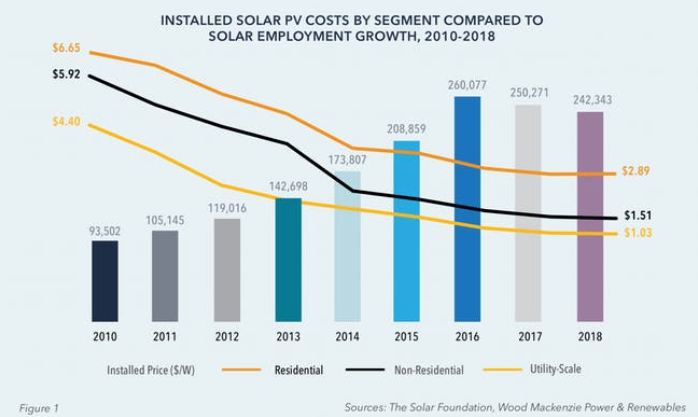US Residential Solar Installs Hit 2 Million In Q2
The US residential solar market is now over 2 million installations, and forecasts expect solar installations to double by 2023, according to Wood Mackenzie Power & Renewables and the Solar Energy Industries Association (SEIA). The Q2 record comes just three years after the industry completed its 1 millionth residential installation, a feat that took 40 years to accomplish.
“The rapid growth in the solar industry has completely reshaped the energy conversation in this country,” said Abigail Ross-Hopper, SEIA president and CEO. “This $17 billion industry is on track to double again in five years, and we believe that the 2020s will be the decade that solar becomes the dominant new form of energy generation.”
Wood Mackenzie forecasts that there will be 3 million installations in 2021 and 4 million in 2023, continuing the swift rise of solar. The key to this prediction may be a comparable drop in costs, which Tesla reckons it can move down to $1.75 per watt, while the ITC holds out at a full 30% for the rest of this year. The staged reduction in the ITC takes it to zero at the end of 2022.

State and utility subsidies of residential solar are still an option in many areas of the country, and that possibility will be enhanced as more public utility commissions begin to put a value on the contribution of distributed energy resources — including residential — for specific locations on a given utility grid.
This rise in solar installations this year is being driven in large part by falling costs. Residential solar installation prices moved down from $6.65 per watt for a residential install in 2010 to $2.89 per watt in 2018. Elon Musk’s Tesla is threatening to lower the cost even further this year by standardizing residential solar packages at 4 kilowatts.
One reason that residential solar costs are higher than commercial and industrial, or utility costs is that the customer acquisition is expensive for installers. During fourth quarter of 2018, Sunrun, the nation’s largest residential installer, spent $0.65 per watt on sales and marketing compared to an installation cost of $2.48. Tesla is moving to eliminate door-to-door sales by offering online purchasing of a residential solar system, thus driving costs lower.
California represented 51% of the first million installations but accounted for 43% of the second million. This is in large part due to a growing residential sector that is rapidly diversifying across state markets. South Carolina, for instance, was an emerging market in 2016 with 1,160 cumulative installations. Today, the state is home to more than 18,000 solar systems and is expected to add 22,000 systems over the next five years.
Other fast-growing states over the last three years include Texas, Utah, Florida, Rhode Island, and Maryland, which combined have grown from around 50,000 installations to more than 200,000. Looking ahead, Illinois will see cumulative installations increase from 4,000 today to nearly 100,000 by 2024.
While California will continue to lead the nation in installations, the remaining top 10 state markets will see faster growth. Nearly 750,000 installations are expected in those markets over the next 5 years, compared to 500,000 installations over the last 5 years.
“According to our latest forecasts, by 2024, there will be on average, one solar installation per minute,” said Michelle Davis, Senior Solar Analyst with Wood Mackenzie. “That’s up from one installation every 10 minutes in 2010.”
“Our nation is harnessing homegrown sunshine at scale to lower electric bills, create jobs, reduce harmful pollution, and build a brighter future for our children and grandchildren,” said Adam Browning, executive director of Vote Solar. “This remarkable progress is a true American success story made possible by customers, workers, policymakers, advocates and innovators. It shows us both what’s possible and how much farther we can go when it comes to an urgent transition to clean energy.”
Today, the 2 million residential, commercial, and utility-scale solar installations produce enough electricity each year to power more than 12 million American homes. By 2024, 2.5% of all US homes will have a solar installation. The total amount of solar generating capacity that goes along with the 2 million solar installations has now eclipsed 70 gigawatts.
Wood Mackenzie, a Verisk Analytics business, is a trusted source of commercial intelligence for the world’s natural resources sector.
Celebrating its 45th anniversary in 2019, the Solar Energy Industries Association is the national trade association of the US solar energy industry, which now employs more than 242,000 Americans. SEIA works with its 1,000 member companies to build jobs and diversity, champion the use of cost-competitive solar in America, remove market barriers and educate the public on the benefits of solar energy.
From: https://cleantechnica.com/2019/05/09/u-s-residential-solar-installs-hit-2-million-in-q2/

